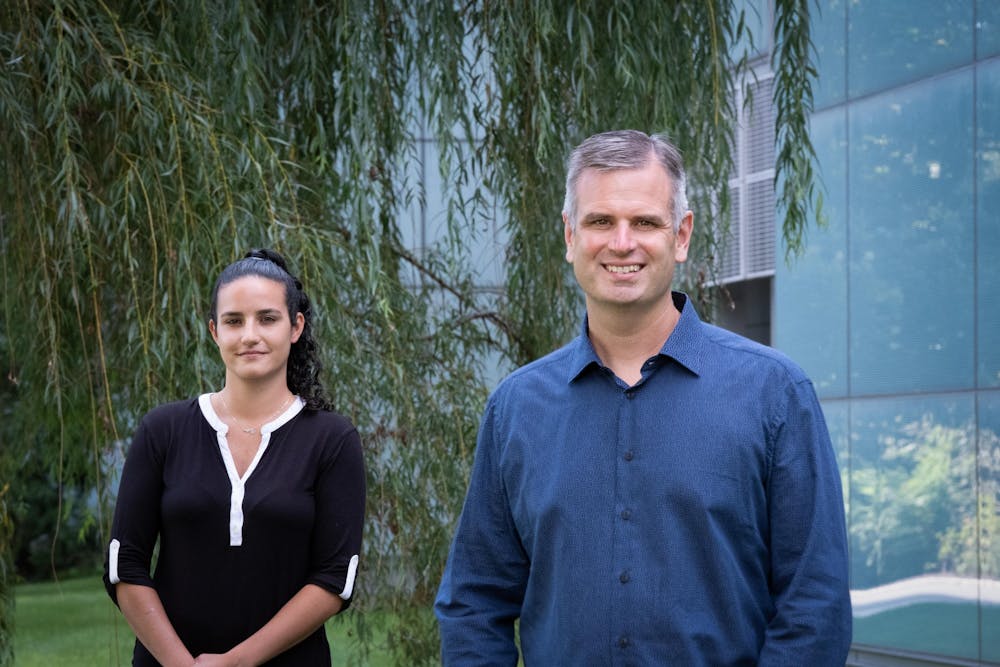A lab led by chemistry professor Paul Chirik reported in late January the structure of a novel molecule with the potential to serve as a building block to engineering more recyclable plastics.
The molecule, oligocyclobutane, is connected with a pattern of repeating squares, which can flip between a connected and disconnected state depending on the conditions it is exposed to. The connected state of the molecule is known as a polymer, while the individual disconnected subunits are referred to as monomers. These monomers can be reused to reform the molecule.
Chirik’s lab started with butadiene, a monomer regularly used to make commercial plastic products.
“We took [butadiene] and made a new plastic comprised of repeating squares,” Chirik explained in an email to The Daily Princetonian.
“No one has seen that before,” he added.
The primary author of the paper is Megan Mohadjer Beromi, a postdoctoral research fellow in the Chirik lab. In an email to the ‘Prince,’ Beromi described the importance of the discovery in the context of how plastics currently threaten the environment.
“Most commercial plastics that contribute to environmental accumulation of waste are extremely difficult to break down into their constituent parts, meaning that useful materials cannot be extracted from them,” she wrote.
The reported molecule’s ability to flip between a connected and disconnected state may help resolve the lack of extractability in current commercial plastics, which means that this discovery has the potential to serve as a step toward more recyclable plastics.

“The monomers can then be recovered and reused, in theory, to generate our new plastic again. Since this has the potential to be done over and over again, our new plastic has the potential to be infinitely recycled,” Beromi continued in her email.
Chirik’s colleagues in the Department of Chemistry echoed excitement for the discovery.
In an email to the ‘Prince,’ Chemistry Department Chair Gregory Scholes wrote, “Paul’s work is a remarkable innovation. The problem of the environmental impact of packaging is widely appreciated, and for decades scientists have thought about how to produce more readily recyclable or degradable plastics. The new work from Paul Chirik’s group presents a fresh paradigm on how to achieve that aim.”
“It is superb science, and [I] think it will be influential,” he added.

In his email, Chirik highlighted the contributions of his postdoctoral researchers to the discovery. The project itself began in 2017, when then-postdoctoral researcher and current faculty member at the University of Rochester C. Rose Kennedy observed the build-up of a liquid while conducting a reaction. Kennedy went on to determine that the formation of polymers was taking place in the reaction.
“She did this through being observant of side reactions and being creative,” Chirik wrote.
The research is still in its early phases. In his email, Chirik explained that the lab hopes to better understand ways to more efficiently produce and reuse the polymer in collaboration with other labs at the University.
“In the near term we are making better catalysts for both the synthesis of the polymer and for chemically recycling it,” he wrote. “What’s great about Princeton is the enthusiasm from colleagues across campus about the work.”
“We are engaging with engineers and other scientists to extend the concept into broader classes of materials, study their fate in the environment, and ultimately how best to recycle them,” he continued.
Beromi is excited to see how the identified molecule may be combined with other polymers to design recyclable next-generation plastics.
“The physical properties of our new ‘polymer of squares’ are drastically different from other polymers of similar composition and size, so it will be really interesting to see what variants of commodity items we can make out of it,” she wrote in her email.
Chirik’s lab broadly focuses on transition metal ion catalysts that are naturally abundant in the Earth. Their recyclable plastic research is centered on helping the environment.
“We are interested in a new plastics age, one where the end of life of a plastic is considered in its design. Personally, I think this principle should be adopted widely and extend beyond plastic and into everything we make and use,” Chirik wrote.
Beromi echoed this interest in her email, writing that she has “always been interested in ‘green’ chemistry and developing chemistry with less impact on the environment.”
She additionally highlighted the contributions of Kennedy and the Andlinger Center for Energy and the Environment in their preliminary research and their industrial collaborators in evaluating the molecule’s properties.
She wrote, “It has been amazing to work with such a diverse and talented group of people, and we are grateful to everyone for their contributions to this project!”
Chirik expressed excitement for the future of the research and praise for Beromi, writing that “[she] has done some exceptional detective work to give us a plan for the future.”








